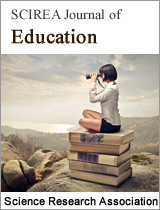Evaluating the Impact of a Textile-Based STEM Class Lecture on Middle School Learners: A Pre- and Post-Test Likert Analysis
DOI: 10.54647/education880609 21 Downloads 8833 Views
Author(s)
Abstract
STEM education often overlooks the practical, tactile domains of textiles and fashion, despite their strong connections to materials science, engineering, sustainability, and innovation. The world of textiles is evolving rapidly, gaining increased visibility and relevance across industries. Yet, despite its growing significance, many children remain unaware of the diverse career opportunities within the textile field. Textile education plays a crucial role in bridging this gap by introducing students to professions they may never have considered—far beyond the traditionally familiar roles of teacher, doctor, firefighter, or musician. By actively incorporating textiles into early educational experiences, we broaden students’ understanding of innovation, sustainability, and science in everyday life. Continued exposure can inspire future careers as textile engineers, technologists, chemists, product developers, and other specialized roles that combine creativity with STEM. Elevating textile education ensures that the next generation recognizes the full spectrum of possibilities within this dynamic and essential industry. This study evaluated the effectiveness of an interdisciplinary textile-based STEM guest lecture designed to increase middle school students’ conceptual understanding of scientific principles in clothing and footwear, and their interest in STEM topics. The purpose was to expose students (n=75) to textile themes and topics to introduce, engage, and promote their understanding of textiles for potential future study of the topic. Students were given the same pre- and post-test of 7 questions and 5 Likert scale outputs ranging from strongly disagree to strongly agree. Data revealed students understanding of textiles increased drastically with a Wilcoxon change value of +2.19, and paired T-test significance across all questions suggesting the class lecture had a strong, significant effect on students understanding related to textiles science and textile applications.
Keywords
STEM education, textiles, engineering, apparel, footwear, middle school.
Cite this paper
Kedena Henriques-Thompson, Andrianna Hodges,
Evaluating the Impact of a Textile-Based STEM Class Lecture on Middle School Learners: A Pre- and Post-Test Likert Analysis
, SCIREA Journal of Education.
Volume 10, Issue 4, August 2025 | PP. 148-155.
10.54647/education880609
References
| [ 1 ] | Archer, L., DeWitt, J., Osborne, J., Dillon, J., Willis, B., & Wong, B. (2015). Not girly, not sexy, not glamorous: Primary school girls’ and parents’ constructions of science aspirations. Pedagogy, Culture & Society, 21(1), 171–194. |
| [ 2 ] | Bybee, R. W. (2010). Advancing STEM education: A 2020 vision. Technology and Engineering Teacher, 70(1), 30–35. |
| [ 3 ] | Cunningham, C. M., & Lachapelle, C. P. (2014). Designing engineering experiences to engage all students. Advances in Engineering Education, 4(1). |
| [ 4 ] | Honey, M., Pearson, G., & Schweingruber, H. (Eds.). (2014). STEM integration in K-12 education: Status, prospects, and an agenda for research. National Academies Press. |
| [ 5 ] | Maltese, A. V., & Tai, R. H. (2011). Pipeline persistence: Examining the association of educational experiences with earned degrees in STEM among U.S. students. Science Education, 95(5), 877–907. |
| [ 6 ] | National Research Council. (2011). Successful K-12 STEM education: Identifying effective approaches in science, technology, engineering, and mathematics. The National Academies Press. |
| [ 7 ] | Osborne, J., Simon, S., & Collins, S. (2003). Attitudes towards science: A review of the literature and its implications. International Journal of Science Education, 25(9), 1049–1079. |
| [ 8 ] | Springer Nature. (2023). International Journal of STEM Education: Submission Guidelines. Retrieved from: https://stemeducationjournal.springeropen.com/submission-guidelines |
| [ 9 ] | Tan, E., Calabrese Barton, A., Kang, H., & O'Neill, T. (2013). Desiring a career in STEM-related fields: How middle school girls articulate and negotiate identities-in-practice in science. Journal of Research in Science Teaching, 50(10), 1143–1179. |
| [ 10 ] | Uzunboylu, H., & Tuncay, N. (2010). Stakeholders’ perceptions of a university's distance learning system. Procedia-Social and Behavioral Sciences, 2(2), 5143–5148. |

